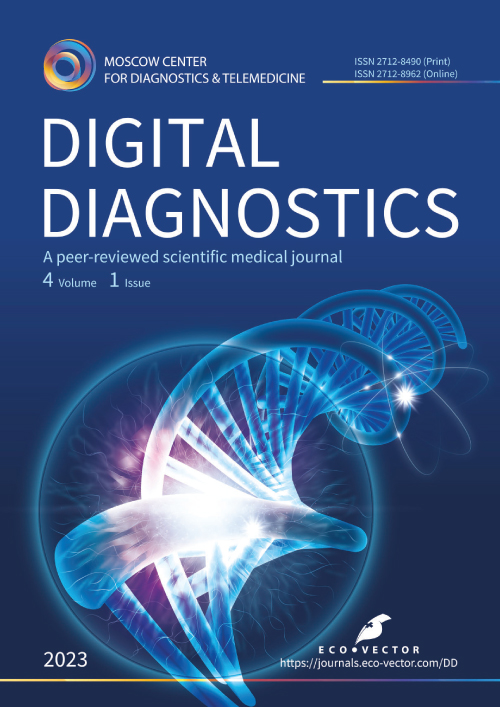COVID-19患者的肺部动态磁共振成像: 一系列临床病例
- 作者: Vasilev Y.A.1, Grik E.A.2, Panina O.Y.1,3,4, Khoruzhaya A.N.1, Semenov D.S.1, Bazhin A.V.1, Vasileva Y.N.4
-
隶属关系:
- Moscow Center for Diagnostics and Telemedicine
- Lincoln Medical Center
- City Clinical Oncological Hospital 1 of the Department of healthcare of the city of Moscow
- Moscow State University of Medicine and Dentistry named after A.I. Evdokimov
- 期: 卷 4, 编号 1 (2023)
- 页面: 71-79
- 栏目: 临床病例及临床病例的系列
- ##submission.dateSubmitted##: 19.11.2022
- ##submission.dateAccepted##: 17.03.2023
- ##submission.datePublished##: 19.04.2023
- URL: https://jdigitaldiagnostics.com/DD/article/view/114723
- DOI: https://doi.org/10.17816/DD114723
- ID: 114723
如何引用文章
详细
一场新冠状病毒感染(COVID-19)的广泛流行导致了对其诊断特征的积极性研究。与COVID-19相关的急性病毒性肺炎是已经在计算机断层扫描(CT)、辐射成像和静态磁共振成像(MRI)的研究中详细描述的。然而,文献中有很少关于通过动态MRI观察到的描述性图片的数据。鉴于综合诊断方法,放射科医生知道如何通过MRI正确识别和解释COVID-19是很重要的。在这一系列临床病例中,我们展示了动态MRI工作方法的威力,使我们能够看到“cloudy sky”的迹象,并将其与COVID-19患者的固结区分开来,使我们能够推测区分早期或轻微的变化和渐进的临床过程。因此,MRI作为一种无辐射的工具,在进行CT扫描的机会有限和需要动态形态功能成像的情况下是非常有用的。
全文:
研究现实性
因为肺部症状占据主导地位,由SARS-CoV-2引起的新型冠状病毒感染(COVID-19)成为近两年来的一个重要研究对象。与感染相关的在胸部计算机断层扫描(CT)上看到的初期证候是单侧局灶性或双侧弥漫性的磨玻璃样阴影,这些浑浊逐渐加剧并导致肺实质增厚(实变)[1,2]。
在这一流行病开始时,由于缺乏具体的实验室诊断资金,胸部CT扫描结果被认为是决定病人是否应该通过实验室方法检测COVID-19的一个可能因素。后来这种作为筛查的方法被抛弃了,现在只有在有临床表现时才建议进行胸部CT扫 描[3 ,4]。在严重疾程的情况下,胸部CT扫描是反复进行的,以监测病情,这不可避免地导致高辐射暴露。由于断层扫描仪的软件不断改进,胸部磁共振成像(MRI)是肺部病变放射诊断的一个很好的发展方向。由于具有某些优势,特别是没有辐射暴露,在某些情况下,肺部MRI可以被认为是首选的方法[5-7]。
我们的一系列病例介绍了SARS-CoV-2检测呈阳性时患者的肺部动态MRI。MRI是在出现病毒性肺炎症状(低热或中度热、干咳嗽、无力)的几天后进行的。文章描述了急性COVID-19病毒性肺炎的病理变化,这些变化是通过动态MRI在三个平面上获得的胸腔电影图像来检测的。
一系列病例的描述
MRI扫描。患者在3T磁共振扫描仪(Signa Pioneer,General Electric,美国)上接受仰卧位的检查,使用了腹部和台面集成的椎体射频线圈。扫描是在不使用呼吸触发器和自由呼吸的情况下进行的。为了尽量减少与呼吸运动有关的动态伪影,射频线圈被固定。该研究是在自由呼吸时进行的,使用了横膈膜运动的自动同步来优化数据采集时间。磁共振电影成像是采用单次激发快速自旋回波(single shot fast spin echo,SSFSE)获得的,附加参数:TR 1460 ms,TE 108.6 ms,旋转角度90º,FOV 450´450 mm,矩阵384×256,切片厚度6 mm,切片间距6 mm,平均数0.6,K空间填充方式(非线性)。为了获得这些图像,我们要求病人慢慢吸气,在脑子里数到十,然后以同样的方式慢慢呼气。对于每个病人,我们在三个正交平面内获得三个动态图像。
MRI分析。我们搜索的主要对象是较高信号强度的多边形区域(相对于肌肉组织的高强度,但相对于肺部实变区的低强度,即信号不如实变区强烈),这可能表现云雾状征象(cloudy sky sign)。我们还注意到在吸气和呼气时病变区域的信号强度变化。
病例1
患者(女性,45岁)在出现干咳嗽和轻微发 烧(低于37.5ºC)的症状后第5天来到诊所。吸气时冠状面的肺部动态磁共振成像(图1)显示了,右肺下叶(S9-10)有一个高信号区,被解读成中央区增厚(信号更强)和周围的云雾状暗 区(信号不太强)。在轴状和矢状面,在相应的区域发现了表明实变的高信号,沿其边缘有云雾状征象。在呼气结束时,冠状面中上述区域的信号强度增加(图2),由于肺组织萎缩,患部的视觉大小减少。在轴状和矢状面,呼气时信号强度没有明显变化。
不论呼吸相位如何,相同高信号可能表明肺泡浸润(实变),呼气时信号不太强烈的区域可能表明中间变化(云雾状征象)。
图1。吸气时在冠状面、轴状面和矢状面的肺部动态磁共振成像。箭头表示轴向和矢状面的增厚区,箭头表示冠状面的云雾状征象(S9-10)。
图2。呼气时在冠状面、轴状面和矢状面的肺部动态磁共振成像。箭头表示实变区(S9-10)。
病例2
一名患者(女性,25岁)的症状表现为干咳嗽、严重发烧(体温达到39ºC)、发冷、,胸口沉重感。该妇女在第一次发病后的第6天来到医院,当时症状变得极为明显。动态磁共振成像显示了,左肺下叶(S6、S8-9)有一个广泛的较高信号区。吸气时,在冠状面、轴状面和矢状面都有不均匀的较高信号(图3)。在呼气 时(图4),冠状面和矢状面的信号强度增加,患部的视觉大小增加,云雾状暗区扩大。一个可能的解释是呼气时肺组织萎缩。
图3。吸气时在冠状面、轴状面和矢状面的肺部动态磁共振成像。橙色箭头表示吸气时可见的实变区(S6、8-9),白色箭头表示有云雾状征象区。
图4。呼气时在冠状面、轴状面和矢状面的肺部动态磁共振成像。箭头表示受影响的组织区域,其中包括标出的间质(云雾状征象)和肺泡(增厚)两种变化的区域,在呼气时可以区分出来(见图3)。
胸式呼吸运动也会对扫描水平有影响,从而对观察到的情况也有影响。在轴状的磁共振影像上,吸气时在信号增强区外围注意到的云雾状征象在呼气时变得更加强烈,这可能是由于肺实质增厚的增加。
病例3
一名患者(男性,49岁)在出现轻微咳嗽和低热(低于至37.5ºC)的症状后第2天来到诊所。动态肺部MRI显示了云雾状征象的占优势的情况,这被不同的信号强度和信号变化区的大小证实,取决于呼吸周期的相位。在冠状面、轴状面和矢状面,吸气时(图5)在右肺下叶检测到一个低强度的信号(S6,S9-10)。呼气结束时的冠状面和矢状面图像(图6)保留了所述区域的较高信号强度及其大小的增加。在轴状面,呼气时云雾状征象更加明显,同时可见肺组织病变区扩大。
图5。吸气时冠状面、轴状面和矢状面的肺部动态磁共振成像。箭头表示与云雾状模式相符合的低强度信号 区(S6、S9-10)。
图6。呼气时在冠状面、轴状面和矢状面的肺部动态磁共振成像。箭头表示与云雾状模式相符合的低强度信号区的增加(S6、S9-10)。
讨论
计算机断层扫描是COVID-19肺炎以及其他病毒性肺炎时评估肺部的金标准。SARS-CoV-2急性冠状病毒肺炎的早期症状在胸部CT图像上最常出现为磨玻璃样阴影(ground-glass opacities,GGO)。标志着肺泡病变的实变区通常出现在疾病的后期阶段。
我们在患有病毒性肺炎病人的MRI上发现变化,其机制是发炎实质的存在,因此,从其接收的信号放大。在MRI扫描中类似的GGO是云雾状征象,它是病毒性肺炎的确证[5]。在动态系列中,我们观察到呼气时云雾状样的信号强度增厚并吸气时的明显变薄。这一征象可能是急性病毒性肺炎中肺组织早期变化的一个指标。我们认为,反映肺泡受累的实变在呼吸过程中没有明显变化。因此,肺部动态MRI可以区分实变和GGO的区域,这在肺部静态MRI中并不总是可能的。
我们的作者团队以前曾使用MRI-LUNG协 议[5](静态扫描模式)对病人进行了检查,并发现了,影像学的实质病变与通过CT扫描确定的病变相似。实时研究使我们能够确定,当使用MRI时,自由呼吸的肺部扫描可以快速进行,并且不会给病人带来不适。我们研究的局限性是缺乏CT数据的演示,以对检测到的模式进行比较。
其他科学小组已经研究了患有COVID-19时的MRI应用[6、8-14]。例如,D.Dong等人[8]认为MRI可能对孕妇和儿童的诊断有帮助;B.K.Fields等人[9]对不同的诊断方法(CT、MRI、正电子发射断层扫描和CT的结合)进行了比较,并证实了这一假设。在德国,M.C.Langenbach等 人[10]接待了一个因原发性肺癌而接受MRI扫描的病人,并发现了下长叶的变化,这些变化表明病人患有COVID-19病毒,随后这一假设得到了证实。G. Szarf等人[11]介绍了一个临床病例,他们描述了MRI上有的类似于云雾状征象的小叶旁浑浊,以及实变,这种实变可能表明病人患有组织性肺炎。S.Akhlaghpoor等人[12]获得了类似的成像模式。通过MRI获得了类似的COVID-19引发的病毒性肺炎的影像学,显示并详述了8个临床病例。除了这些变化外,H. Dheir等人[13]还描述了结节(11名患者在MRI上检测到结节,12名患者在CT上检测到结节),其敏感性和特异性分别为91.67和100%。
结论
一些临床病例清楚地表明,动态MRI技术允许看到云雾状征象(类似于CT中的GGO模式),并将其与COVID-19患者的实变识别出来。
结果显示,肺部动态MRI扫描比标准的静态扫描协议会有优势。然而,虽然有潜力,但肺部MRI仍然是一种实验性工具,需要进一步研究以确定其在COVID-19患者管理中的作用。尽管如此,观察到的模式也可能适用于肺部的其他病理状况。
ADDITIONAL INFORMATION
Funding source. The article was prepared with the support of the Moscow Department of Health as part of the research work (No. EGISU: АААА-А21-123031500007-6) in accordance with the program “Scientific support of the capital’s healthcare” for 2023-2025.
Competing interests. The authors declare that they have no competing interests.
Authors’ contribution. All authors made a substantial contribution to the conception of the work, acquisition, analysis, interpretation of data for the work, drafting and revising the work, final approval of the version to be published and agree to be accountable for all aspects of the work. Yu.A. Vasiliev, A.V. Bazhin, Yu.N. Vasilyeva, D.S. Semenov — concept and design of the study, editing and approval of the final version of the manuscript text, advisory support for clinical and technical parts; E.A. Grik, O.Yu. Panina — study concept and design, analysis of MRI studies, description of clinical cases; A.N. Khoruzhaya — literature analysis, writing the text of the article, editing.
Consent for publication. Written consent was obtained from the patients for publication of relevant medical information and all of accompanying images within the manuscript Digital Diagnostics journal.
Acknowledgments. The authors are grateful for the help in developing the concept of the study, as well as for the organizational and methodological support of K.A. Sergunova, S.P. Morozov, A.G. Masri, A.V. Midaev and E.A. Sule
作者简介
Yuriy A. Vasilev
Moscow Center for Diagnostics and Telemedicine
Email: y.vasilev@npcmr.ru
ORCID iD: 0000-0002-0208-5218
SPIN 代码: 4458-5608
MD, Cand. Sci. (Med.)
俄罗斯联邦, MoscowEvgeniia A. Grik
Lincoln Medical Center
Email: evgeniyagrik@gmail.com
ORCID iD: 0000-0002-7908-3982
SPIN 代码: 5558-7307
美国, The Bronx, NY
Olga Yu. Panina
Moscow Center for Diagnostics and Telemedicine; City Clinical Oncological Hospital 1 of the Department of healthcare of the city of Moscow; Moscow State University of Medicine and Dentistry named after A.I. Evdokimov
Email: o.panina@npcmr.ru
ORCID iD: 0000-0002-8684-775X
SPIN 代码: 5504-8136
俄罗斯联邦, Moscow; Moscow; Moscow
Anna N. Khoruzhaya
Moscow Center for Diagnostics and Telemedicine
编辑信件的主要联系方式.
Email: a.khoruzhaya@npcmr.ru
ORCID iD: 0000-0003-4857-5404
SPIN 代码: 7948-6427
俄罗斯联邦, Moscow
Dmitriy S. Semenov
Moscow Center for Diagnostics and Telemedicine
Email: d.semenov@npcmr.ru
ORCID iD: 0000-0002-4293-2514
SPIN 代码: 2278-7290
俄罗斯联邦, Moscow
Alexander V. Bazhin
Moscow Center for Diagnostics and Telemedicine
Email: a.bazhin@npcmr.ru
ORCID iD: 0000-0003-3198-1334
SPIN 代码: 6122-5786
俄罗斯联邦, Moscow
Yulia N. Vasileva
Moscow State University of Medicine and Dentistry named after A.I. Evdokimov
Email: drugya@yandex.ru
ORCID iD: 0000-0002-1066-3989
SPIN 代码: 9777-2067
MD, Cand. Sci. (Med.)
俄罗斯联邦, Moscow参考
- Shi H, Han X, Jiang N, et al. Radiological findings from 81 patients with COVID-19 pneumonia in Wuhan, China: A descriptive study. Lancet Infectious Dis. 2020;20(4):425–434. doi: 10.1016/S1473-3099(20)30086-4
- Salehi S, Abedi A, Balakrishnan S, Gholamrezanezhad A. Coronavirus Disease 2019 (COVID-19): A systematic review of imaging findings in 919 patients. Am J Roentgenol. 2020;215(1):87–93. doi: 10.2214/AJR.20.23034
- ACR Recommendations for the use of chest radiography and computed tomography (CT) for suspected COVID-19 infection [cited March 11, 2020]. Available from: https://www.acr.org/Advocacy-and-Economics/ACR-Position-Statements/Recommendations-for-Chest-Radiography-and-CT-for-Suspected-COVID19-Infection. Accessed: 15.01.2023.
- Temporary guidelines “Prevention, diagnosis and treatment of new coronavirus infection (COVID-19)”. Version 16 (08/18/2022). Moscow; 2022. 249 p. (In Russ).
- Vasilev YA, Sergunova KA, Bazhin AV, et al. Chest MRI of patients with COVID-19. Magn Reson Imaging. 2021;(79):13–19. doi: 10.1016/j.mri.2021.03.005
- Vasilev YuA, Sergunova KA, BazhinАV, et al. Chest MRI of a pregnant woman with COVID-19 pneumonia. Digital Diagnostics. 2020;1(1):61−68. doi: 10.17816/DD46800
- Vasiliev YuA, Panina OYu, Kudryavtsev ND, et al. Magnetic resonance imaging of the lungs: methodological recommendations. Issue 92. Moscow; 2022. 102 р. (Series «The best practices of radiation and instrumental diagnostics»). (In Russ).
- Dong D, Tang Z, Wang S, et al. The role of imaging in the detection and management of COVID-19: A review. IEEE Rev Biomed Eng. 2021;(14):16–29. doi: 10.1109/RBME.2020.2990959
- Fields BK, Demirjian NL, Dadgar H, Gholamrezanezhad A. Imaging of COVID-19: CT, MRI, and PET. Semin Nucl Med. 2021;51(4):312–320. doi: 10.1053/j.semnuclmed.2020.11.003
- Langenbach MC, Hokamp GN, Persigehl T, Bratke G. MRI appearance of COVID-19 infection. Diagn Interv Radiol. 2020;26(4):377–378. doi: 10.5152/dir.2020.20152
- Fonseca EK, Chate RC, Neto RS, et al. Findings of COVID-19 on magnetic resonance imaging. Radiology Cardiothoracic Imaging. 2020;2(2):e200193. doi: 10.1148/ryct.2020200193
- Torkian P, Rajebi H, Zamani T, et al. Magnetic resonance imaging features of coronavirus disease 2019 (COVID-19) pneumonia: The first preliminary case series. Clin Imaging. 2021;(69):261–265. doi: 10.1016/j.clinimag.2020.09.002
- Ates OF, Taydas O, Dheir H. Thorax magnetic resonance imaging findings in patients with coronavirus disease (COVID-19). Acad Radiol. 2020;27(10):1373–1378. doi: 10.1016/j.acra.2020.08.009
- Ussov WY, Nudnov NV, Ignatenko G, et al. Primary and prospective imaging of the chest using magnetic resonance imaging in patients with viral lung damage in COVID-19. Med Visualizat. 2020;24(4):11–26. (In Russ). doi: 10.24835/1607-0763-2020-4-11-26
补充文件



















